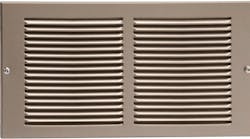Recurring Design Defects
A good quality design requires much more work than finding the nominal rated airflow of a bath fan or heat recovery ventilator in the sales literature, and slapping a model number into a building plan schedule. Unfortunately, when HVAC contractors bid a plan and spec job and the customer complains about air quality issues 6 months later, the designer is long gone and the contractor is left holding the bag.
Many of the most common design defects are frequently repeated. One of the most common issues is assuming airflow rating of the fan without checking its static pressure rating also. For example, many bath fans are rated at a minimal airflow that meets ASHRAE 62.2, but the fan’s rated static pressure is so weak it prohibits the installation of ductwork. When installed with ducting, the end result will be low airflow and poor fan performance.
A good designer should select a fan that has the fan rated capacity to overcome the resistance to airflow caused by the backdraft damper, the exhaust duct and the exhaust termination fitting. When this is done, the installed system will have the ability to deliver the design airflow.
Another recurring design defect is placing the fan in a location where there’s not a good route for the duct to terminate to the outdoors. Basically, the designer specified a ventilation device as an afterthought and now the contractors has to shoehorn the ducts in place and pray for an airflow miracle. Once again, compliance is met on paper, but not delivered to the end user.
The solution to this problem is for the contractor to become proactive. An effective review of the design and the plans by the installing contractor will identify the problem and the issue should be noted in the proposal. An alternative duct route and a fan with increased capacity can be identified and a change order submitted.
Common Installation Defects
Don’t be too quick to pin the lack of performance on the designer, we build our share of defects into a building too. Installers that have never had their work tested and verified at the time of installation are missing the feedback loop that prevents defects from showing up over and over again.
Most common problems in residential ventilation systems are super easy to accidentally create during construction. Mistakes as easy as forgetting to cut the tape holding the backdraft damper closed can cause decades of steamy mirrors and foul smelling bathrooms.
Failing to fully extend a flexible exhaust duct to full length and cutting off the excess duct can doom a heat recovery ventilator to a shortened life in the company of aggravated homeowners.
Another classic problem occurs when an installer uses two 25-ft. boxes of flexible duct to terminate an exhaust on the opposite side of the house, two stories above the fan location because the installer didn’t want to cut an extra penetration in the outside of the building.
Airflow is invisible and unless measured, it remains invisible. Because the installing contractor failed to measure and verify adequate performance of the system, the building occupants are saddled with a ventilation issue, often for the life of the building.
How to Field Measure Airflow
HVAC contactors can measure the performance of the ventilation systems they install using time proven air-balancing methods. Numerous ASHRAE standards that have existed for decades already support these verification methods and could be pointed to and customized to measure various ventilation applications.
A balancing hood can effectively measure ventilation airflows within the published capacity of the hood. Airflow over 30 CFM can be measured by covering the grille with the hood and reading the airflow on the face of the instrument.
Compare the actual airflow with the design airflow and assure it’s within plus or minus 10% of the specified airflow. If airflow is high, adjust fan speed, if applicable, or install a balancing damper and reduce airflow by closing the damper. If airflow is low, verify that the duct size is to plan, or look for restrictions or obstructions in the exhaust duct. You may also check the operation of the backdraft damper and assure it is functional.
What Manufacturers Could Do to Make Verification Easier
In the near future, a progressive ventilation equipment manufacturer will take the HVAC industry by storm and capture immediate market share by building an air measurement station into the body of residential ventilation fans. This should be done by using two pressure ports and a fixed orifice size.
The installing contractor or verifier will then attach a manometer to the two pressure ports accessible through the grill or at the fan housing. The pressure drop of the fixed orifice can then be measured. The manufacturer will provide a table in the ventilation equipment installation instructions listing the corresponding airflow at a given pressure drop.
This is a very low cost option if added to a ventilation device that can assure credibility to the designers and installers through a simple and quick verification method. Test instruments are also low cost and easy to use and can be purchased for less than $200.
Such advancement in ventilation fans would revolutionize the way standards are written and implemented in the industry. Surely other industry standards lacking verification would follow the leadership of such a progressive action.
Rob “Doc” Falke serves the industry as president of National Comfort Institute an HVAC based training company and membership organization. If you're an HVAC contractor or technician interested in an contractors in-field test procedure for heat recovery ventilators contact Doc at [email protected] or call him at 800-633-7058. Go to NCI’s website at nationalcomfortinstitute.com for free information, articles and downloads.










